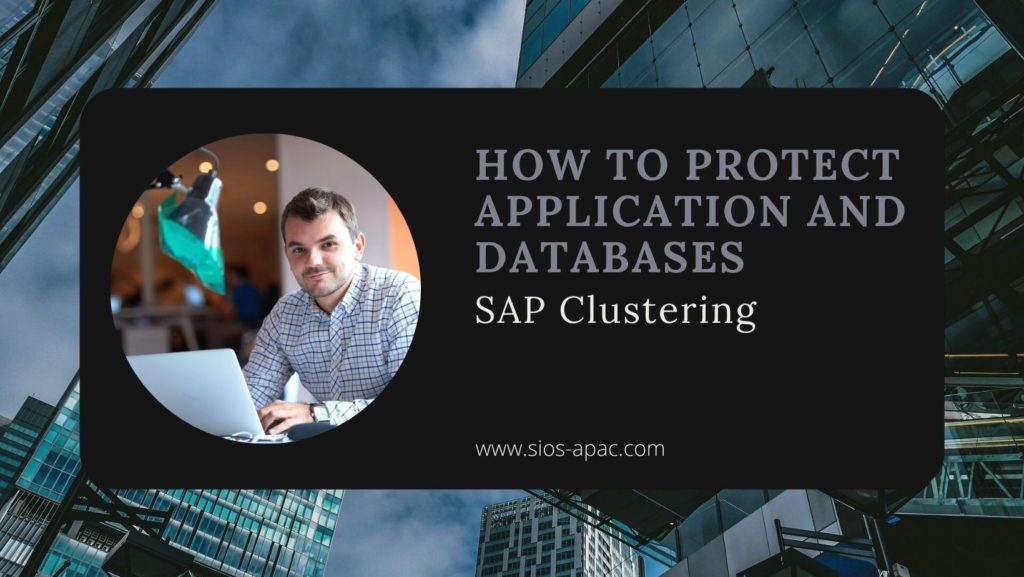How to Protect Application and Databases – SAP Clustering
SAP Clustering: The Best Way to Achieve High Availability
What is SAP Clustering?
Your SAP system is the lifeblood of your organization and if the system is down, your operations stop. To support high availability of your SAP system, your IT team can install SAP in a cluster environment.
A cluster is a group of two or more connected servers that are configured with the same operating system, databases, and applications. These connected servers are referred to as “nodes.” One of the nodes is designated as the primary node. If a primary node fails, clustering allows your organization to automatically fail over application operation to one or more secondary nodes, mitigating downtime, eliminating data loss, and maintaining data integrity.
High availability SAP clustering solutions are available for servers that run in Linux or in Windows environments.
Popular SAP Clustering Solutions
The front-end application needs high availability, i.e. S/4 HANA, as does any other app that is HANA dependent.
There are several open-source HA solutions for SAP from Linux vendors, such as SUSE and RedHat, that include HA extensions with their “Enterprise for SAP” subscriptions. These vendors bundle in open source software you can use to build high-availability clusters for HANA database, ABAP SAP Central Service (ASCS), Evaluated Receipt Settlement (ERS), and other SAP components.[1]
SUSE HAE (and other open-source clustering options) are highly manual and only protect individual components. For example, integrating SUSE HAE and other open source solutions with SAP or SAP HANA can be time-consuming and complex, requiring careful, manual scripting and tedious confirmation steps. Specific deep expertise in the applications and database are also required to create an application-aware HA solution.
SAP also offers HANA System Replication, a feature that comes with the HANA software. It provides continuous synchronization of an SAP HANA database to a secondary location either in the same data center, remote site, or in the cloud. The data is replicated to the secondary site and preloaded into memory. When a failure happens, the secondary site will take over without a database restart, which helps to reduce the Recovery Time Objective (RTO). Unfortunately, failback to the primary node must be manually triggered with separate commands issued. There is also no integrated HA failover orchestration together with SAP Central Services etc. components. [2]
SIOS HA clustering software provides comprehensive SAP-certified protection for your applications and data, including high availability, data replication, and disaster recovery in an easy, cost-efficient solution. SIOS software lets you protect SAP in Windows or Linux environments, using the server hardware of your choice in any combination of physical, virtual, cloud (public, private, and hybrid) and high-performance flash storage environments. SIOS software is easily configured and provides fast replication, comprehensive monitoring, and protection of the entire SAP application environment. It offers continuous data availability in either a shared (SAN) storage or share-nothing (SANless) storage environment.
For SAP S/4HANA and the SAP HANA databases, SIOS can be used to complement what SAP is already doing with the HANA system replication to provide complete automated high-availability – automated monitoring of key SAP HANA application processes, and automated failover and failback.[3]
SIOS Protection Suite Protects SAP in Linux Environments
The SIOS Protection Suite for Linux provides a tightly integrated combination of high availability failover clustering, continuous SAP application monitoring, data replication, and configurable recovery policies, protecting your SAP application from downtime and disasters. While SIOS Protection Suite can operate in a SAN environment to support a traditional HA hardware-based cluster, the architecture takes a shared-nothing approach to server clustering allowing it to run SANless. It delivers a robust, versatile and easily configurable solution with automatic and manual failover/failback recovery policies for a wide variety of applications.
SIOS Protection Suite for Linux Supports SAP Clustering as Follows:
- SIOS LifeKeeper, which provides flexible failover clustering software that monitors the entire application stack
- SIOS DataKeeper, which provides fast, efficient host-based, block-level data replication for mirroring local storage in a SANless cluster configuration or replicating to remote locations or cloud for disaster recovery
- Multiple Application Recovery Kits (ARKs), with automated configuration and validation tools built into the product to protect your business-critical applications, such as SAP, and data from downtime and disasters.
Application Intelligence Maintains Best Practices Failover
ARKs provide application-specific awareness and connect the application stack to the HA solution in context, including all dependent components. For example, SIOS offers an SAP HANA Application Recovery Kit, which provides host auto-failover, storage replication, and system replication to increase availability.
Lastly, with the SIOS Protection Suite for Linux, you can run your business-critical applications in a flexible, scalable cloud environment, such as Amazon Web Services (AWS) and Azure, without sacrificing performance, high availability, or disaster protection.
SIOS DataKeeper Protects SAP in Windows Environments
SIOS DataKeeper Cluster Edition is a software add-on that simply and seamlessly integrates with WSFC to add performance-optimized, host-based synchronous or asynchronous replication. With DataKeeper, you can easily create a SANless cluster to achieve high availability and disaster recovery for your SAP application, whether operating in the cloud, in a virtualized environment such as VMware, or on physical servers using only local storage. It adds efficient replication to synchronize local storage on each cluster node, creating a SANless cluster that appears to WSFC like traditional storage. With it, you can create a Windows cluster in a cloud, hybrid cloud, or extend a traditional on-premises SAN-based cluster with a node in the cloud for disaster recovery.
Using SIOS DataKeeper Cluster Edition, you can achieve high availability protection to critical SAP components including ABAP SAP Central Service (ASCS) Instance, back-end databases (Microsoft SQL Server, Oracle, DB2, MaxDB, MySQL, and PostgreSQL), the SAP Central Services Instance (SCS).
SIOS DataKeeper not only eliminates the cost, complexity, and single-point-of-failure risk of a SAN, but also lets you use the latest in fast PCIe Flash and SSD in your local storage for performance and protection in a single cost-efficient solution.
SIOS DataKeeper also provides SAP high availability and disaster recovery in cloud environments, such as Amazon Web Services (AWS), Microsoft Azure, and Google Cloud Services without sacrificing performance.
If your organization does not use WSFC, SIOS offers Protection Suite for Windows, which includes SIOS DataKeeper, SIOS LifeKeeper, and optional Application Recovery Kits (ARKs) for leading applications such as SAP, and infrastructure operations. It is a tightly integrated SAP clustering solution that combines high availability failover clustering, continuous application monitoring, data replication, and configurable recovery policies to protect your business-critical SAP application and data from downtime and disasters.
Conclusion
Organizations across the globe use SIOS HA solutions to protect their SAP application, whether running in a Windows or Linux environment. Here are just a few examples:
- Bonfiglioli is a leading Italian design, manufacturing and distribution company used SIOS DataKeeper to give them an easy way to move their SAP system to the Microsoft Azure cloud while meeting stringent SLAs for availability, disaster recovery, and performance.
- Toyo Gosei, a chemical manufacturer, used SIOS DataKeeper to migrate SAP to Azure and build a “system that never stops” with replication.
- Zespri International, the world’s largest marketer of kiwi fruit, used SIOS DataKeeper to provide the configuration flexibility and high availability and disaster protection the company needed to deploy their SAP/Microsoft SQL Server operations in Microsoft Azure.
For more information on high availability SAP clustering, click here.
References
[1] Ibid.
[2] https://blogs.sap.com/2020/05/03/high-availability-and-dr-for-sap-hana-sap-s-4hana-and-sap-central-services/
[3] Ibid.
Reproduced with permission from SIOS

